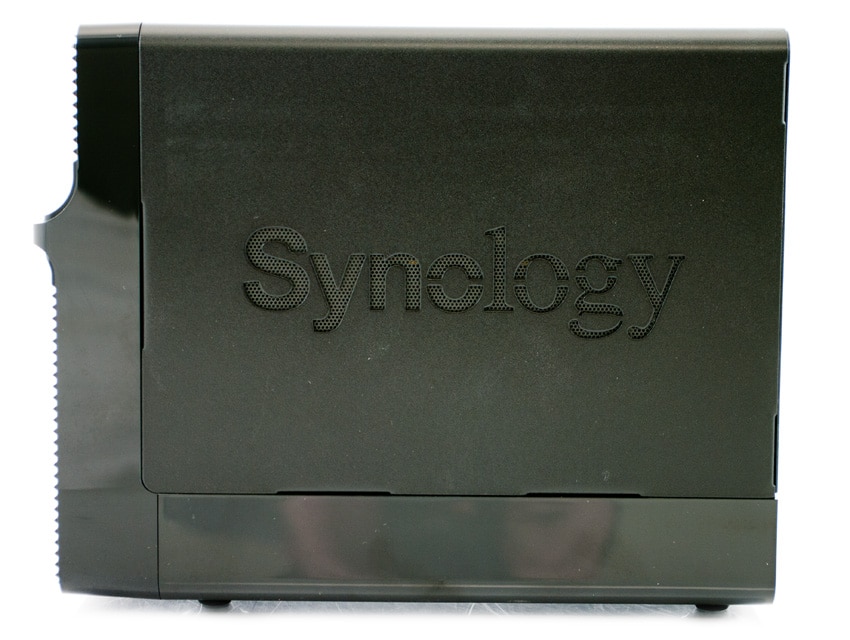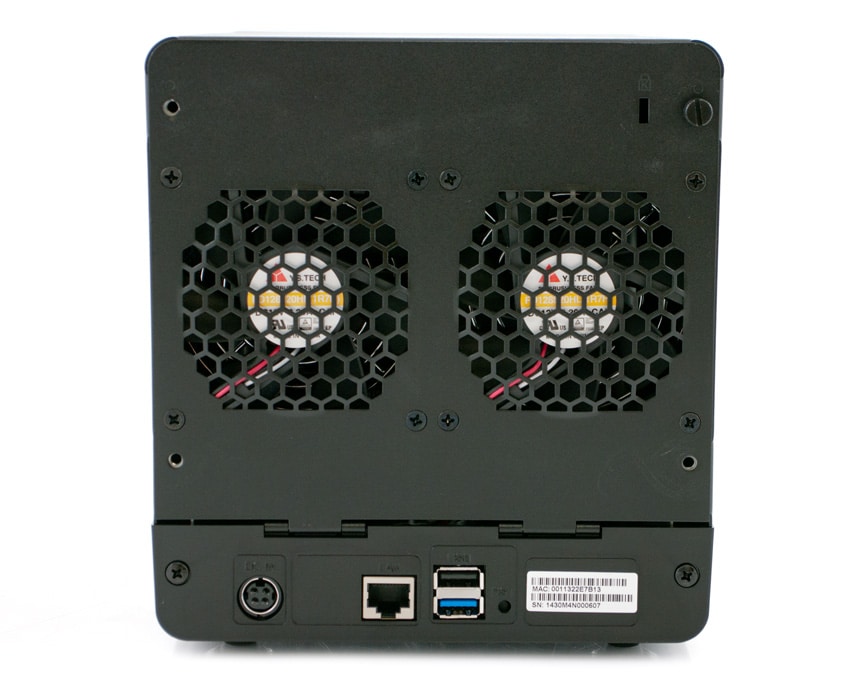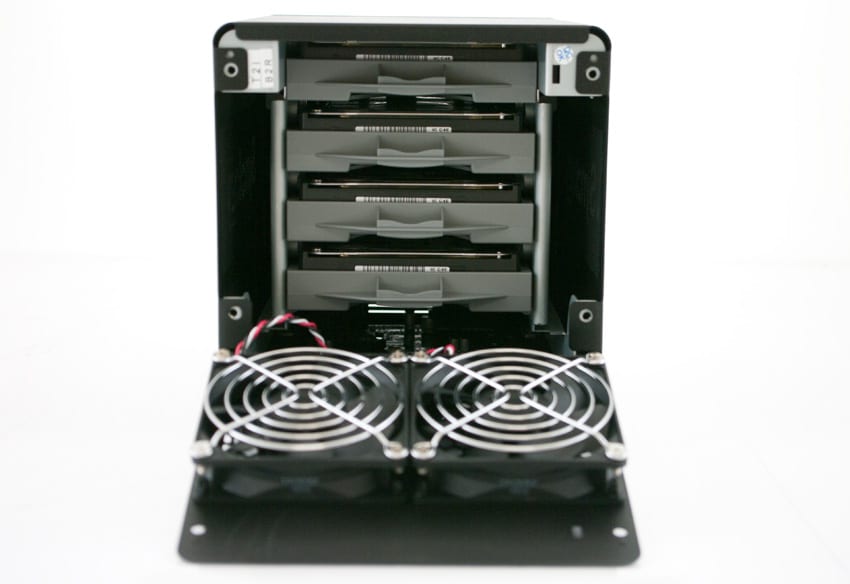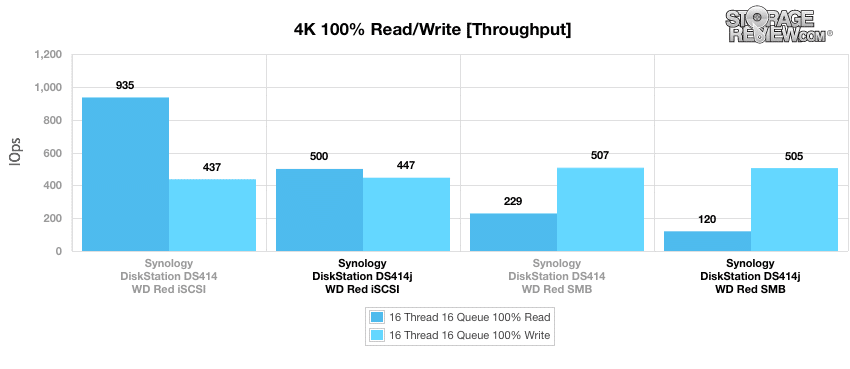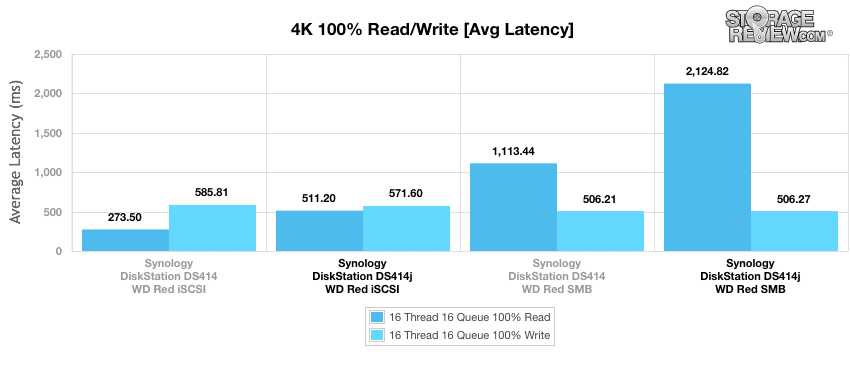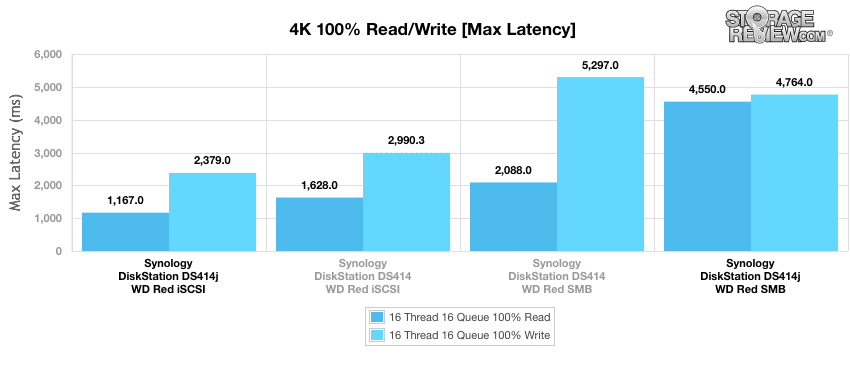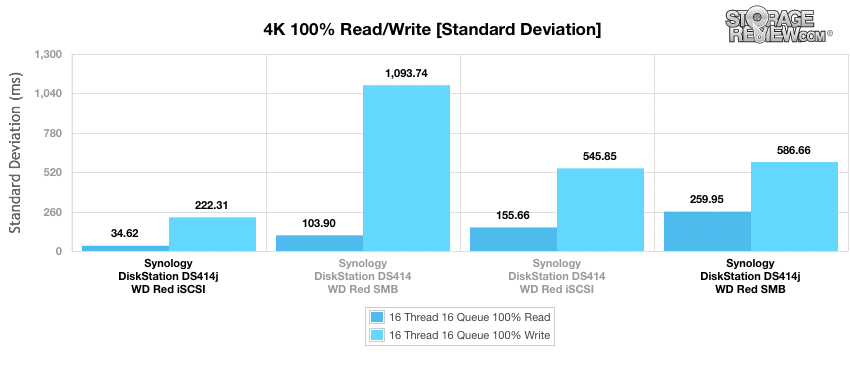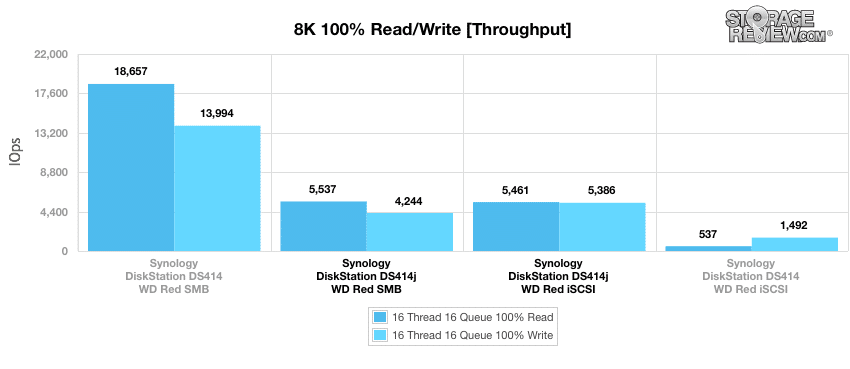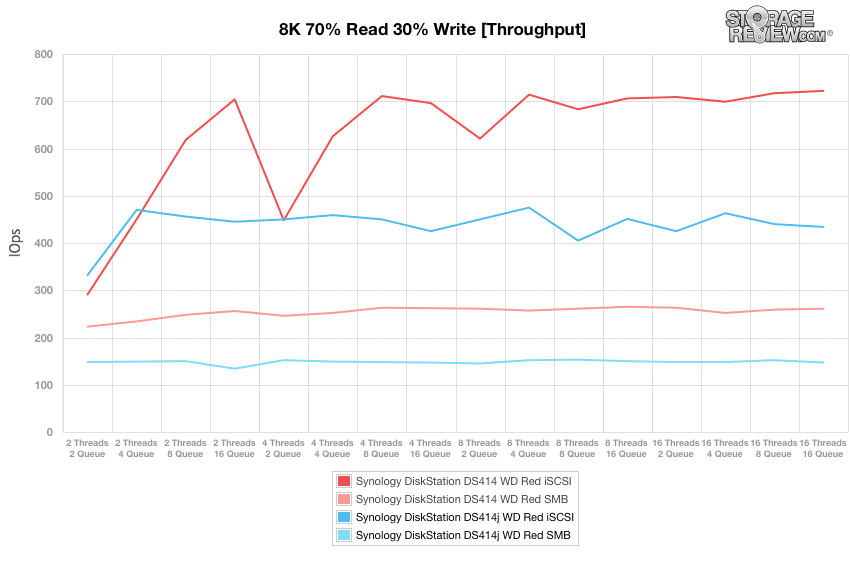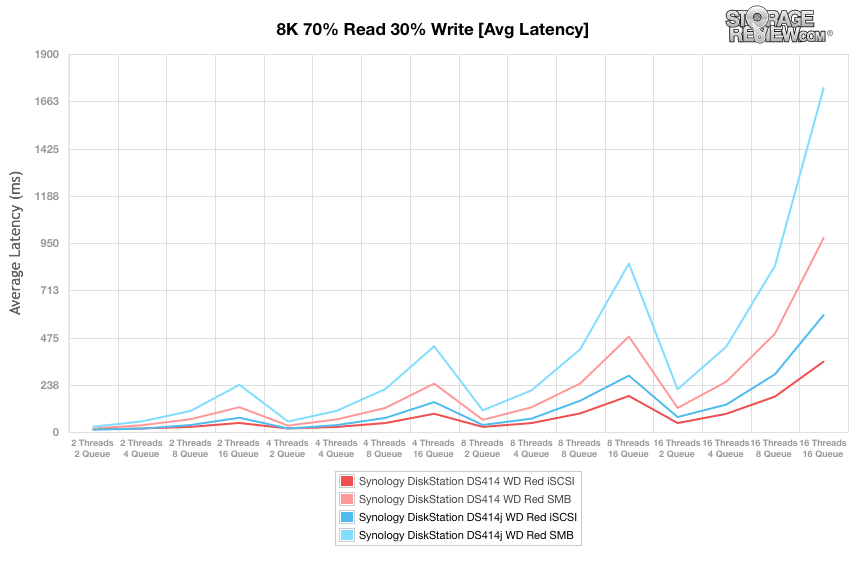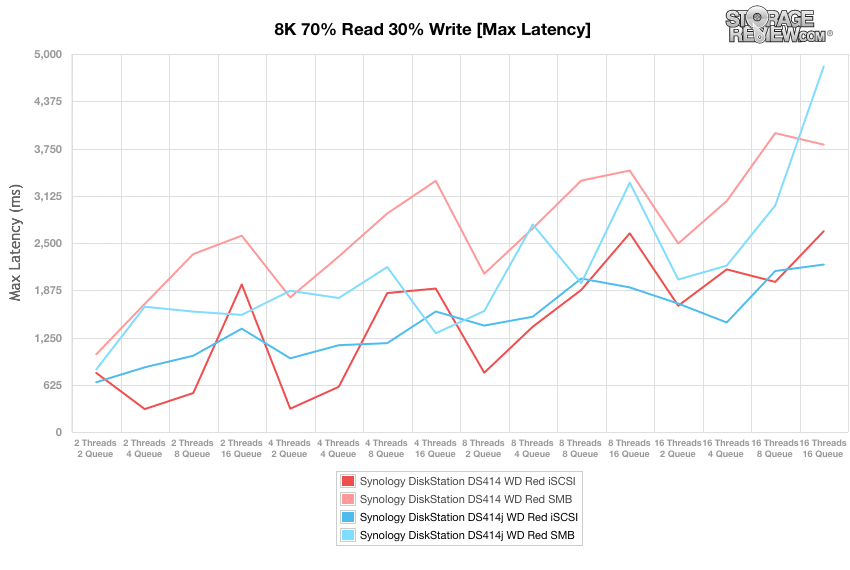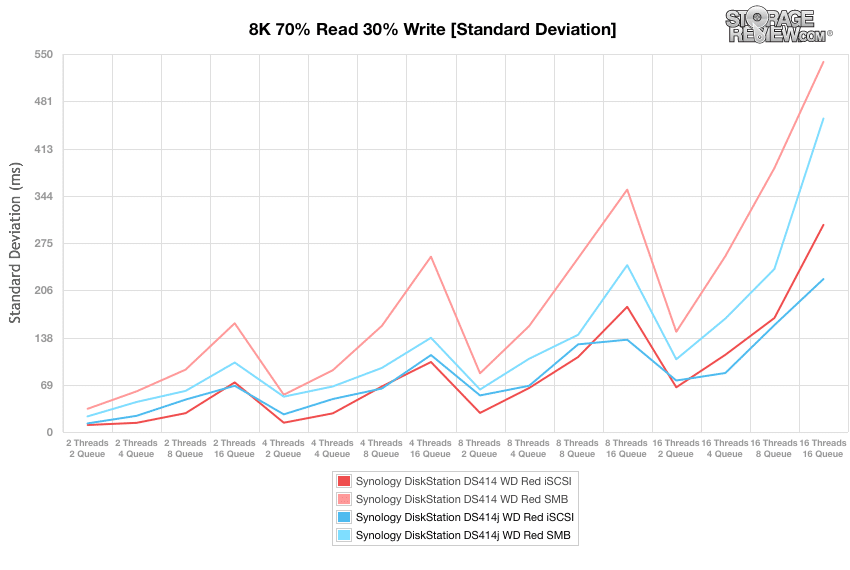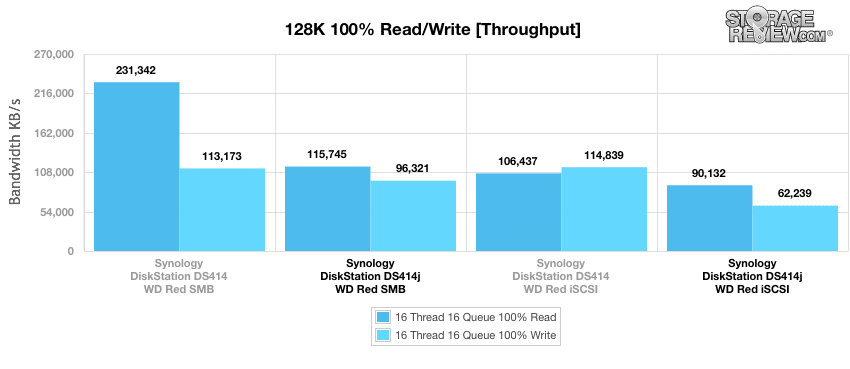The Synology DS414j is a 4-bay NAS that is aimed at small and home offices, with budget in mind. Like the other NAS servers from the “j” series, the DS414j offers a fair amount of performance for its price point. Unlike the previous entries in the "j" series, the DS414j is the first to offer a dual core CPU and a USB 3.0. The processor is a MindSpeed Comcerto2000 this time around instead of the Marvell Kirkwood that had been used in previous models. The DS414j allows cross-platform file sharing, mobile access, and features Synology's award winning OS DiskStation Manager 5.0.
The Synology DS414j is a 4-bay NAS that is aimed at small and home offices, with budget in mind. Like the other NAS servers from the “j” series, the DS414j offers a fair amount of performance for its price point. Unlike the previous entries in the "j" series, the DS414j is the first to offer a dual core CPU and a USB 3.0. The processor is a MindSpeed Comcerto2000 this time around instead of the Marvell Kirkwood that had been used in previous models. The DS414j allows cross-platform file sharing, mobile access, and features Synology's award winning OS DiskStation Manager 5.0.
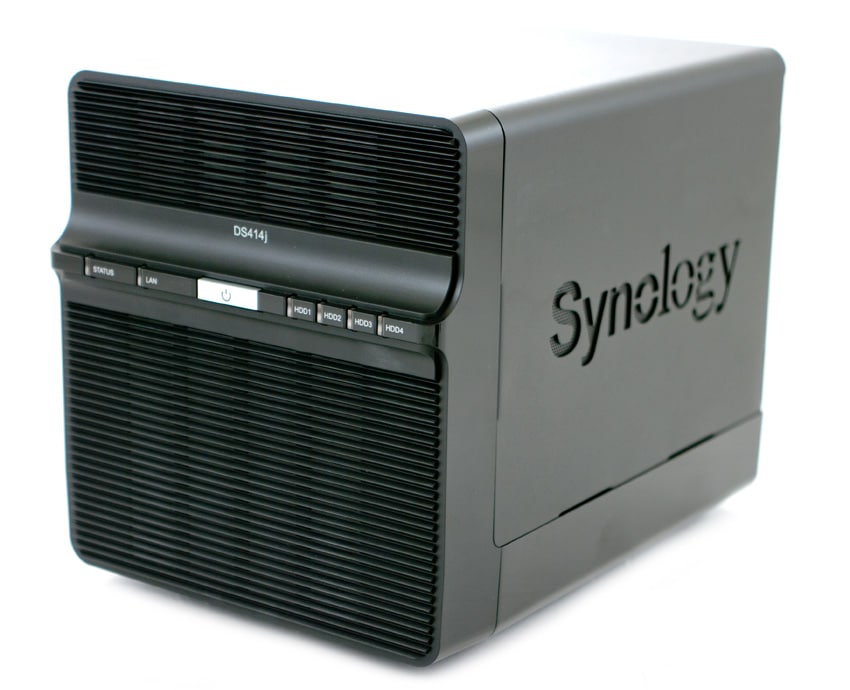
Small and home offices more and more need reliable back-up, with a lot of flexibility, all for a reasonable price. Synology's DS414j addresses this in one neat little package, which his very similar in an appearance to its predecessor. The DS414j claims speeds of 112.28MB/s Read and 80.38MB/s Write. As mentioned above it comes with a USB 3.0 port for increased transfer speeds. Allowing cross-platform sharing is especially helpful in a small office environment where all involved may not have the uniform systems. It has a 20TB capacity, with a large compatibility list for several different drives.
The Synology DS414j carries a street price of $390 and comes with a two-year warranty.
Synology DS414j Specifications:
- CPU Model: MindSpeed Comcerto2000
- CPU Frequency: Dual Core 1.2GHz
- Hardware Encryption Engine
- Floating Point
- Memory: 512MB DDR3
- Internal Drive: EXT4
- Max Internal Capacity: 20TB (5TB HDD x 4)
- External ports: USB 2.0 x 1; USB 3.0 x 1
- Compatible Drive Types:
- 3.5" SATA(III) / SATA(II) HDD
- 2.5" SATA(III) / SATA(II) HDD
- 2.5" SATA(III) / SATA(II) SSD
- Dimensions (Height x Width x Depth): 184mm x 168mm x 230mm
- Weight: 2.21kg
- LAN: Gigabit x 1
- Wireless Support (dongle)
- System Fan: 80mm x 80mm x 2pcs
- Power:
- Power supply: 90W
- AC Input Power Voltage: 100V to 240V AC
- Power Frequency: 50/60Hz single phase
- Power Consumption: 36.7W (Access); 8.5W (HDD Hibernation)
- Environmental:
- Operating Temperature: 5°C to 35°C (40°F to 95°F)
- Storage Temperature: -10°C to 70°C (15°F to 155°F)
- Noise Level: 18.9 dB(A)
- Relative Humidity: 5% to 95% RH
- Maximum Operating Altitude: 6500 feet
- Certifications: FCC Class B, CE Class B, & BSMI Class B
- Warranty: 2 years
Design and Build
Unlike much of Synology’s line of NAS and servers, the DS414j isn’t getting a make over to the new sleek, minimalist look. In fact, aside from now being black, it looks the same as its predecessor (as do all the “j” line). It's too bad really, these toaster-esque enclosures are very dated at this point, we'd guess that this may be the last of them as Synology works through existing inventory. Considering how nice their modern designs are this one is decidedly utilitarian at best.
The front of the NAS has a grated appearance with a power button in the middle and LED indicator lights on either side: status and LAN to the left of the power button, and 4 HDD lights to the right of the button.
Both sides of the device have Synology branding that also double as additional ventilation.
Around the rear of the device are both fans in the middle side by side. Beneath the fans are all the external ports, from left to right: the AC adapter, the LAN port, and both USB ports, the 2.0 being on top. Right next to the USB ports is a manual reset button. At each corner is a thumbscrew to take the back panel off and insert the drives.
Users must remove the back panel to insert drives. While they are hot swappable, the caddies are not tool-less like most of Synology's other models. For most this won't be a problem, but it is a pain to swap drives in the event the need comes up.
Performance
We tested both CIFS and iSCSI performance using WD Red a popular 3.5" 5,400RPM hard drives that is suited for to operate in NAS environments. We also compared the performance of the DS414j to the DS414.
Drives tested for this review:
- WD Red 4TB (5,400RPM)
- RAID1 SMB
- RAID1 iSCSI
The StorageReview Enterprise Test Lab allows us to provide relevant and unbiased benchmarks of enterprise storage devices by establishing a testing environment comparable to what IT administrators encounter in real datacenter and field deployments. The Enterprise Test Lab incorporates a variety of servers, networking, power conditioning, and other infrastructure to design real-world configurations that accurately reflect the performance of storage devices during reviews.
We incorporate details about our lab environment and testing protocols into the review so that administrators and those responsible for equipment acquisition can fairly gauge the conditions under which we have achieved these published results. None of our reviews are paid for or controlled by the manufacturer of equipment we are testing. Additional details about the StorageReview Enterprise Test Lab and an overview of its networking capabilities are available on those respective pages.
In order to fairly evaluate the performance of the Synology DiskStation DS414j we need an environment that ensures that the DS414j is the I/O bottleneck rather than the network. Therefore this review employs a Lenovo ThinkServer RD240 running multiple Windows Server 2012 VMs in an ESXi 5.1 environment connected via a quad-port Intel i350-T4 NIC through a Netgear ProSafe GS752TXS switch.
- 2 x Intel Xeon X5650 (2.66GHz, 12MB Cache)
- Windows Server 2008 Standard Edition R2 SP1 64-Bit running on VMware ESXi 5.1
- Intel 5500+ ICH10R Chipset
- Memory – 32GB (4 x 8GB) 1333Mhz DDR3 Registered RDIMMs
Netgear ProSafe GS752TXS Smart 52-port Switch
- 48 1GbE Ports, 4 10GbE SFP+ Uplink Ports
- 176Gbps Aggregate Bandwidth
Enterprise Synthetic Workload Analysis
Our enterprise hard drive benchmark process preconditions each device into steady-state with the same workload the device will be tested with under a heavy load of 16 threads with an outstanding queue of 16 per thread, and then tested in set intervals in multiple thread/queue depth profiles to show performance under light and heavy usage. Since hard drives reach their rated performance level very quickly, we only graph out the main sections of each test.
- Preconditioning and Primary Steady-State Tests:
- Throughput (Read+Write IOPS Aggregate)
- Average Latency (Read+Write Latency Averaged Together)
- Max Latency (Peak Read or Write Latency)
- Latency Standard Deviation (Read+Write Standard Deviation Averaged Together)
Our Enterprise Synthetic Workload Analysis includes four profiles based on real-world tasks. These profiles have been developed to make it easier to compare to our past benchmarks as well as widely-published values such as max 4k read and write speed and 8k 70/30, which is commonly used for enterprise drives.
- 4k
- 100% Read or 100% Write
- 100% 4k
- 8k 70/30
- 70% Read, 30% Write
- 100% 8k
- 128k (Sequential)
- 100% Read or 100% Write
- 100% 128k
In the first of our enterprise workloads, we measured a long sample of random 4k performance with 100% write and 100% read activity to get our main results. The DS414’s WD Red 4TB iSCSI provided the greatest throughput in read activity at 935IOPS, while the DS414j’s WD Red 4TB iSCSI had a read throughput of 500 IOPS. Both DiskStations had a higher write throughput with WD Red 4TB SMB, the DS414 just nudged out the DS414j with 507IOPS to 505IOPS respectively.
Next we took a look average latency. With a heavy 16T/16Q load, the leaders of the pack were the opposite of the throughput above. The DS414’s WD Red 4TB iSCSI had the lowest read latency with 273.5ms and both WD Red 4TB write latency were almost the same, the DS414’s being 506.21ms (the lower of the two) and the DS414j’s being 506.27ms.
Comparing max latency between the two NAS units, this time we saw the DS414j perform better with its WD Red 4TB iSCSI measuring a peak of 1167ms read and 2379ms write, edging out the DS414’s iSCSI measurements by about 500ms on both accounts.
Reviewing the 4K latency consistency in our standard deviation section, the DS414j WD Red 4TB iSCSI had the best latency with a read speed of 34.62ms and a write speed 222.31ms with none of the other readings coming close.
Our next benchmark measures 100% 8K sequential throughput with a 16T/16Q load in 100% read and 100% write operations. While the WD Red 4TB iSCSI and the WD Red 4TB SMB ran fairly close on the DS414j (iSCSI had a throughput of 5,386IOPS write and 5,461IOPS read and that SMB had a throughput of 4,244IOPS write and 5,537IOPS read the iSCSI running better on write and SMB better on read), the DS414 WD Red 4TB SMB crushed the rest with throughput at 13994IOPS write and 18,657IOPS read.
Compared to the fixed 16 thread, 16 queue max workload we performed in the 100% 4k write test, our mixed workload profiles scale the performance across a wide range of thread/queue combinations. In these tests, we span workload intensity from 2 threads and 2 queue up to 16 threads and 16 queue. In the expanded 8k 70/30 test, while both iSCSI WD Red 4TB ran higher the DS414 had the highest throughput with the DS414j had a throughput that leveled off in the 400-500IOPS range peaking at 475IOPS.
With the 8k 70/30 average response times, the WD Red 4TB iSCSI drives had lower latency with the DS414 having the lowest and the DS414j trailing just behind.
With max latency, we see both WD Red 4TB iSCSI drives trading back and forth for the lowest latency. However the DS414j did have the lowest average response times looking at max latency.
For the entirety of the thread/queue spectrum, again the WD Red 4TB iSCSI drives traded for the lowest response times and averaging out the times again shows the DS414j ahead but only by 1.5ms.
The last test in our Enterprise Synthetic Workload testing is the 128k test, which is a large block sequential test that shows the highest sequential transfer speed for a platter drive. Looking at the 128k performance of 100% write and 100% read activity, the WD Red 4TB SMB drives were dominant on read activity, with the DS414 unsurprisingly beating out the DS414j. The DS414j did have a read activity of 115,745KB/s and a write activity of 96,321KB/s. The WD Red 4TB iSCSI did have the best write activity at 114,839KB/s.
Conclusion
The Synology DS414j is a 4-bay NAS with a value focus that replaces the DS413j. It comes with more power and a few new options for the same price as its predecessor. The first in the “j” series to come with a dual core processor and USB 3.0 port, the DS414j also runs DSM 5.0 with all the new features that entails. It is ideal for home to small offices that need plenty of capacity (it has a maximum of 20TB), cross-platform file sharing, mobile access, and reliable back-up.
We measured the performance of the Synology DiskStation DS414j using popular Western Digital 4TB drive that is optimized for use in small NAS platforms. We found random 4K access performance to top at 500IOPS read and 505IOPS write and 8K performances topping at 5,537IOPS read and 5,386IOPS write. And we found the device to have large-block sequential speeds at 115MB/s read and 96MB/s write outperforming the claimed speed put forth from Synology, the claimed speeds being 112.28MB/s Read and 80.38MB/s Write. We also compared it to the little more upscale DS414, which is targeted to SMB and consumers, as opposed to the DS414j that is aimed at small to home offices. Unsurprisingly it did perform lower but it does have a slower processor and less RAM, it does however carry a lower price point. There were a few times where the DS414j did outperforming the DS414, it did have better response times with max latency and standard deviation.
Pros
- Performed faster than claimed
- Good price point for its capacity
Cons
- External design and drive mounting is dated
- No expansion support
The Bottom Line
The Synology DS414j is a reasonably powerful, cost effective NAS for SOHO use. It's not going to blow the doors off, but for small workgroups that can benefit from all a NAS and Synology's deep bench of DSM tools can offer, it's a great starting point for shared storage.
Synology DiskStation DS414j at Amazon


